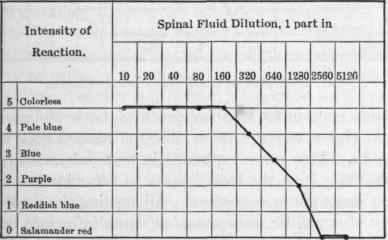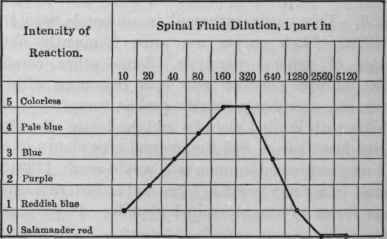Lumbar Puncture - Cell Count - Chemical Tests. Part 3
Description
This section is from the book "Manual Of Psychiatry", by Aaron J. Rosanoff. Also available from Amazon: Manual of Psychiatry.
Lumbar Puncture - Cell Count - Chemical Tests. Part 3
If this titration is satisfactory, the solution is further tested with a specimen of spinal fluid known to have given a paretic curve.
1 Carl Lange. Die Ausflokkung kolloidalen Goldes durch Cerebro-spinalflussigkeit bei syphilitischen Affectionen des Centralnervcnsystems. Zeitschr. f. Chemotherapie, No. 1, 1912. - Kaplan and McClelland. The Precipitation of Colloidal Gold. Journ. Amer. Med. Assn., Feb. 14, 1914.
2 Miller, Brush, Hammers, and Felton. Bulletin of Johns Hopkins Hospital, Vol. XXVI, p. 391, 1915.
If the above titration is unsatisfactory, it is advisable to determine the reaction of the solution with the aid of alizarin red. Both alkalinity and acidity interfere with the reaction, the one retarding and the other hastening it. If found necessary, therefore, the reagent should be neutralized with N/50 hydrochloric acid or sodium hydroxide, as the case might be, using alizarin red as indicator. It is then again titrated with sodium chloride solution, as described above. If the titration is still unsatisfactory, then something may be judged to be wrong either with the chemicals used or with the technique, and a new solution has to be made.
The only other solution required is 0.4% sodium chloride in thrice-distilled water.
The test is performed in the following way: ten small test-tubes are placed in a rack; one puts 1.8 c.c. of the 0.4% sodium chloride solution in the first test-tube in the rack and 1 c.c. in each of the other nine. 0.2 c.c. of the spinal fluid is then put into the first test-tube, making therein a dilution of 1: 10; from this 1 c.c. is taken out and put into the second test-tube, making therein a dilution of 1: 20; this is repeated until the entire series of tubes contain dilutions of the spinal fluid of descending strengths, that in the tenth tube being a dilution of 1: 5120. In order to make the volume of the mixture in the tenth tube the same as in the other tubes, 1 c.c. is taken out and thrown away. To each tube is now added 5 c.c. of the colloidal gold solution, the mixture shaken up, and the rack left to stand at room temperature for twenty-four hours, at the end of which time the reading is taken.
In recording the reading it is customary to distinguish five degrees of intensity of reaction: a negative reaction leaves the fluid in the test-tube salamander red in color, as in the beginning, and is designated 0; a slightly positive reaction is indicated by a reddish-blue color, and is designated 1; a somewhat more strongly positive reaction renders the fluid purple, and is designated 2; the next intensity of reaction is indicated by a blue color, and is designated 3; the next again by a pale blue color, and is designated 4; and the strongest intensity of reaction, marked by complete precipitation, is indicated by a colorless condition of the supernatant fluid, and is designated 5.
The colloidal gold test is essentially a measure of the relationship between the globulins and albumins in the spinal fluid.1 Fluids with a large globulin content and little or no albumin give paretic curves, like the general type shown in Fig. 8. This curve, expressed in numerals, would read: 5555543200. Such curves are most frequently obtained in cases of general paralysis. Some other conditions, notably multiple sclerosis and lead poisoning with brain involvement, sometimes furnish similar curves.

Fig. 8. - Collodial Gold Test: Paretic Curve.
Fluids with limited globulin and moderate albumin content give luetic curves, like the general type shown in Fig. 9. This curve, expressed in numerals, would read: 1133100000. It is most frequently found in tabes and endarteritic and gummatous forms of cerebro-spinal syphilis. It may also be found in cases of brain tumor, cerebral arteriosclerosis, poliomyelitis, etc.
1 Felton. A Study of the Specificity of the Colloidal Gold Reaction from the Physico-Chemical Standpoint. Journ. Amer. Med. Assn., 1917.

Fig. 9. - Colloidal Gold Test: Luetic Curve.
Fluids containing large amounts of both globulin and albumin give meningitic curves, like the general type shown in Fig. 10. This curve expressed in numerals, would read: 1234553100. It is the least helpful of all curves as far as definite diagnosis is concerned. All meningitic conditions, be they of syphilitic, tubercular, or acute infectious nature, show curves of this general type.

Fig. 10. - Colloidal Gold Test: Meningtic Curve.
(C) Special Protein Tests
Noguchi's Butyric Acid Test.1 - To 0.2 c.c. of cerebro-spinal fluid in a small test-tube is added 0.5 c.c. of an aqueous solution containing 10% of butyric acid and 0.9% of sodium chloride, and the mixture is heated over a flame until it boils; while it is still hot 0.1 c.c. of a 4% solution of sodium hydroxide is added and the mixture is boiled again. A positive result is indicated by the appearance at once or after a few minutes of a finely granular or flocculent precipitate which settles in a little while, the supernatant fluid remaining clear. If no precipitate forms or if only a diffuse opalescence develops which does not subside on standing, the reaction is recorded as negative.
Ross-Jones Ammonium Sulphate Test
Upon 2 c.c. of a hot saturated solution of ammonium sulphate, which has been allowed to cool in the test-tube, 1 c.c. of cerebro-spinal fluid is allowed to flow gently from a pipette in such a manner that it will form a layer floating on top. The reaction is positive if within a few minutes a thin grayish ring is formed at the junction of the two liquids. After standing the ring becomes thicker and on close examination in a suitable light against a dark background may be seen to be made up of a fine network of cobweb-like appearance.
Pandy's Phenol Test
The reagent is prepared as follows: Eighty c.c. of pure carbolic acid are dissolved in 1000 c.c. of distilled water. This mixture is well shaken and allowed to stand several days at room temperature. The supernatant clear solution is then pipetted off. About 3 c.c. of this solution is poured into a small test-tube and three drops of spinal fluid are added. The spinal fluid, which is of higher specific gravity than the reagent, falls to the bottom. A positive reaction is indicated by a distinct streak of cloudiness in the course of the spinal fluid through the reagent.
1 Noguchi and Moore. Journ. Exp. Med., 1909, p. 604. - Rosanoff and Wiseman. Syphilis and Insanity. Amer. Journ. of Insanity, Vol. LXVI, 1910, p. 419.
2 British Med. Journ., 1909, Vol. I, p. 1111.
3 D. Kaplan. Serology of Nervous and Mental Diseases: Philadelphia, 1914.
Continue to:


